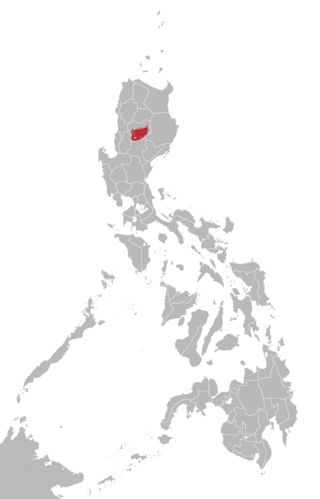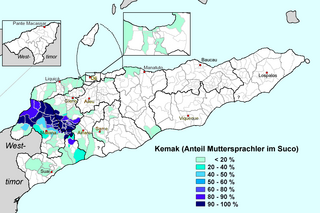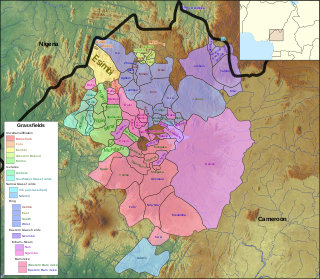Related Research Articles

Ifugao or Batad is a Malayo-Polynesian language spoken in the northern valleys of Ifugao, Philippines. It is a member of the Northern Luzon subfamily and is closely related to the Bontoc and Kankanaey languages. It is a dialect continuum, and its four main varieties—such as Tuwali—are sometimes considered separate languages.

Kemak is a language spoken in East Timor and in the border region of Indonesian West Timor. An alternate name is Ema. It is most closely related to Tocodede and Mambai. It has the status of one of the national languages in the East Timor constitution, besides the official languages of Portuguese and Tetum. The number of speakers has fallen in recent years.
Bruu is a Mon–Khmer dialect continuum spoken by the Bru people of mainland Southeast Asia.
Songe, also known as Songye, Kisonge, Lusonge, Yembe, and Northeast Luba, is a Bantu language spoken by the Songye people in the Democratic Republic of the Congo.

The Kwasio language, also known as Ngumba / Mvumbo, Bujeba, and Gyele / Kola, is a language of Cameroon, spoken in the south along the coast and at the border with Equatorial Guinea by some 70,000 members of the Ngumba, Kwasio, Gyele and Mabi peoples. Many authors view Kwasio and the Gyele/Kola language as distinct. In the Ethnologue, the languages therefore receive different codes: Kwasio has the ISO 639-3 code nmg, while Gyele has the code gyi. The Kwasio, Ngumba, and Mabi are village farmers; the Gyele are nomadic Pygmy hunter-gatherers living in the rain forest.
Ngbaka (Ngbàkà) is a Gbaya language spoken by just over a million people in the Democratic Republic of the Congo. It is a regionally important language, used by the Gilima, Ngbundu, Mbandja and Mono peoples, and is taught in primary schools; 10% are literate in Ngbaka.
The Kukuya language, Kikukuya, also transcribed Kukẅa and known as Southern Teke, is a member of the Teke dialect continuum of the Congolese plateau. It is the only language known to have a phonemic labiodental nasal. The name of the language comes from the word kuya "plateau".
Mumuye is by far the most populous of the Adamawa languages. It is spoken in northeastern Nigeria. It is classified in the Leko–Nimbari branch of Savanna languages, as Adamawa is no longer considered a valid family. According to Ethnologue, there are multiple dialects: Zinna, Rang (Lamma), Dong, Yoro, Lankaviri, Gola (Bajama), Gongla, Kasaa, Saawa, Jalingo, Nyaaja, Jeng, Gnoore, Yaa, Sagbee, Shaari, Kugong, Mang, Kwaji, Meeka, Yakoko.
The Dogon dialects of the western plains below the Bandiagara Escarpment in Mali are mutually intelligible. They are sometimes called the Kan Dogon because they use the word kan for varieties of speech. The dialects are:
Karenni or Red Karen, known in Burmese as Kayah, is a Karen dialect continuum spoken by over half a million Kayah people in Burma.
Gwari is a Nupoid language spoken by the Gbagyi people, which make up over a million people in Nigeria. There are two principal varieties, Gbari and Gbagyi, which have some difficulty in communication; sociolinguistically they are distinct languages.
Central Teke is a member of the Teke languages dialect continuum of the Congolese plateau. Central Teke dialects are Ngungwel and Mpu (Mpumpum), Boo, and Nzikou (Njyunjyu/Ndzindziu). They are spoken in the Malebo Pool region of the Republic of Congo, with an unknown number of Boo speakers in DRC.
North Teke, or Tɛgɛ, is a member of the Teke languages dialect continuum of the Congolese plateau.
Mang, or Mashan Miao also known as Mashan Hmong, is a Miao language of China, spoken primarily in Ziyun Miao and Buyei Autonomous County, southwestern Guizhou province, southwest China. The endonym is Mang, similar to other West Hmongic languages such as Mong.
Bwaidoka is an Austronesian language spoken in Milne Bay Province of Papua New Guinea. It is a local lingua franca.

Babanki, or Kejom, is a Bantoid language that is spoken by the Babanki people of the Western Highlands of Cameroon.
Mengen and Poeng are rather divergent dialects of an Austronesian language of New Britain in Papua New Guinea.
Palantla Chinantec, also known as Chinanteco de San Pedro Tlatepuzco, is a major Chinantecan language of Mexico, spoken in San Juan Palantla and a couple dozen neighboring towns in northern Oaxaca. The variety of San Mateo Yetla, known as Valle Nacional Chinantec, has marginal mutual intelligibility.
Luang, also known as Literi Lagona, is an Austronesian language spoken in the Leti Islands and the Babar Islands in Maluku, Indonesia. It is closely related to the neighboring Leti language, with 89% shared basic vocabulary.
Bunama is an Austronesian language spoken in the D'Entrecasteaux Islands of Papua New Guinea.
References
- ↑ Tsaayi at Ethnologue (18th ed., 2015) (subscription required)
Laali at Ethnologue (18th ed., 2015) (subscription required)
Yaa at Ethnologue (18th ed., 2015) (subscription required)
Tyee (Kwe) at Ethnologue (18th ed., 2015) (subscription required) - ↑ Jouni Filip Maho, 2009. New Updated Guthrie List Online
- ↑ Ntsiba Ngolo, Edouard; Raharimanantsoa, Ruth (2015). Petit guide d’orthographique et de grammaire du Téké du sud-ouest. Brazzaville: SIL Congo.